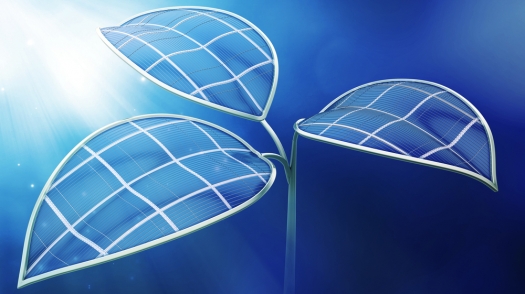Caltech gets one step closer to artificial photosynthesis

Caltech scientists, inspired by a chemical process found in leaves, have developed an electrically conductive film made from NiO that could help pave the way for devices capable of harnessing sunlight to split water into hydrogen fuel.
When applied to semiconducting materials, the film prevents rust buildup and facilitates an important chemical process in the solar-driven production of fuels such as methane or hydrogen. The team has shown that the film is compatible with many different kinds of semiconductors including InP, CdTe and silicon.
"We have developed a new type of protective coating that enables a key process in the solar-driven production of fuels to be performed with record efficiency, stability, and effectiveness, and in a system that is intrinsically safe and does not produce explosive mixtures of hydrogen and oxygen," says Nate Lewis, the George L. Argyros Professor and professor of chemistry at Caltech and a coauthor of a new study, published the week in the online issue of the journal the Proceedings of the National Academy of Sciences, that describes the film.
The team say the development could help lead to safe, efficient artificial photosynthetic systems, also called solar-fuel generators or "˜artificial leaves'- that replicate the natural process of photosynthesis that plants use to convert sunlight, water, and carbon dioxide into oxygen and fuel in the form of carbohydrates, or sugars.
The artificial leaf that Lewis' team is developing in part at Caltech's Joint Center for Artificial Photosynthesis (JCAP) consists of three main components: two electrodes - a photoanode and a photocathode - and a membrane. The photoanode uses sunlight to oxidise water molecules to generate oxygen gas, protons, and electrons, while the photocathode recombines the protons and electrons to form hydrogen gas. The membrane, which is typically made of plastic, keeps the two gases separate in order to eliminate any possibility of an explosion, and lets the gas be collected under pressure to safely push it into a pipeline.
Scientists have tried building the electrodes out of common semiconductors used in solar panels such as silicon or GaAs but a major problem is that these materials develop an oxide layer when exposed to water.
Lewis and other scientists have experimented with creating protective coatings for the electrodes, but all previous attempts have failed for various reasons. "You want the coating to be many things: chemically compatible with the semiconductor it's trying to protect, impermeable to water, electrically conductive, highly transparent to incoming light, and highly catalytic for the reaction to make oxygen and fuels," says Lewis, who is also JCAP's scientific director.
"Creating a protective layer that displayed any one of these attributes would be a significant leap forward, but what we've now discovered is a material that can do all of these things at once."
When applied to photoanodes, the nickel oxide film far exceeded the performance of other similar films - including one that Lewis's group created just last year. That film consisted of two layers versus one and used as its main ingredient TiO2.
"After watching the photoanodes run at record performance without any noticeable degradation for 24 hours, and then 100 hours, and then 500 hours, I knew we had done what scientists had failed to do before," says Ke Sun, a postdoc in Lewis's lab and the first author of the new study.
Lewis's team developed a technique for creating the NiO film that involves smashing atoms of argon into a pellet of nickel atoms at high speeds, in an oxygen-rich environment. "The nickel fragments that sputter off of the pellet react with the oxygen atoms to produce an oxidised form of nickel that gets deposited onto the semiconductor," Lewis says.
The team's film works well in conjunction with the membrane that separates the photoanode from the photocathode and staggers the production of hydrogen and oxygen gases.
"Without a membrane, the photoanode and photocathode are close enough to each other to conduct electricity, and if you also have bubbles of highly reactive hydrogen and oxygen gases being produced in the same place at the same time, that is a recipe for disaster," Lewis says. "With our film, you can build a safe device that will not explode, and that lasts and is efficient, all at once."
Lewis cautions that scientists are still a long way off from developing a commercial product that can convert sunlight into fuel. Other components of the system, such as the photocathode, will also need to be perfected.
"Our team is also working on a photocathode," Lewis says. "What we have to do is combine both of these elements together and show that the entire system works. That will not be easy, but we now have one of the missing key pieces that has eluded the field for the past half-century."
'Stable solar-driven oxidation of water by semiconducting photoanodes protected by transparent catalytic nickel oxide films' by K. Sun et al appears in Proc. Natl. Acad. Sci.































